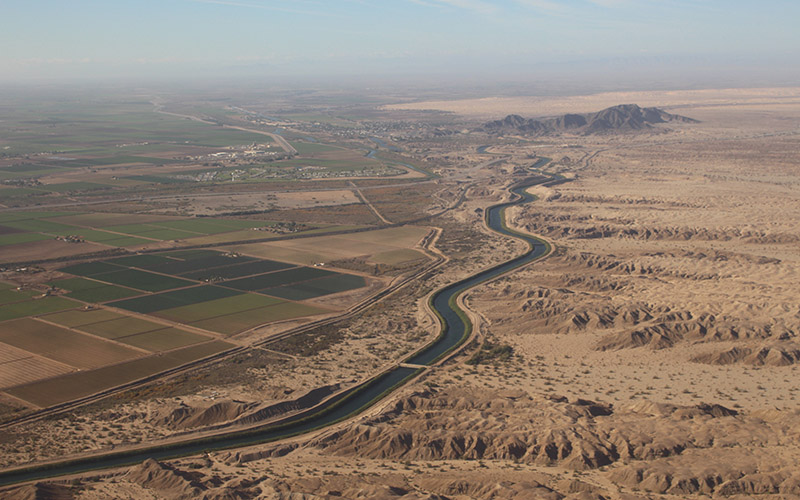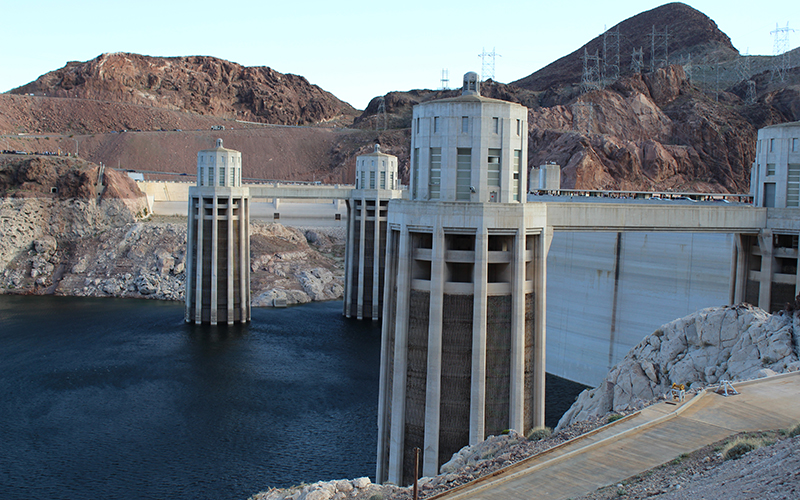
The All-American Canal takes Colorado River water to agricultural areas in Southern California. (Photo by Luke Runyon/KUNC/LightHawk)
LAS VEGAS – Coming to terms with the limits of the Colorado River is like losing a loved one, Keith Moses said.
“It reminds me of the seven stages of grief, because I think we’ve been in denial for a long time,” Moses, vice chairman of the Colorado River Indian Tribes, a group of four tribes near Parker, Arizona, told the annual Colorado River Water Users Association meeting last week.
Denial turned to pain and guilt as it became clear just how big the gap between supply and demand is on a river that delivers water to 40 million people in the Southwest.
For the past six months, Arizona’s water managers have been experiencing the third stage of grief: anger, plus bargaining.

A panel at the Colorado River Water Users Association’s annual conference in Las Vegas discusses progress in the creation of Drought Contingency Plans on Dec. 13. (Photo by Luke Runyon/KUNC)
“Even though we reach situations where maybe we’re about to all break out into a brawl in there, we come back to the table, we continue to work,” Moses said.
Moses is referring to a series of public meetings in Arizona to figure out the details of Drought Contingency Plans. Water managers throughout the West were supposed to finish the plans by the end of 2018. They’re likely to miss that deadline, so the U.S. Bureau of Reclamation has given them one more month. After that, federal officials say they will step in.
The squeakiest wheel
Of the seven U.S. states that rely on the Colorado River, Arizona has had the hardest time figuring out how to rein in water use to avoid drastic drops in the river’s largest reservoirs – Lakes Mead and Powell. For instance, if Mead drops to a level below 1,075 feet elevation from sea level, that would trigger a delivery shortage that mostly affects Arizona cities and farms. In a report last summer, the Bureau of Reclamation predicted that could come by 2020.
Kathryn Sorenson, director of Phoenix’s water utility, characterized the process this way: “Interesting. Complicated. Some might say difficult.”
If arid conditions continue to plague the watershed, as they have the last 19 years, Sorenson said Arizona stands to lose a big portion of its Colorado River water. The details of who takes those cuts, when they take them and under what conditions, are still undecided, keeping the agreements from being signed and implemented.
“That’s a painful conversation,” Sorenson said. “And, of course, everyone thinks that their own water use is justified and no one else’s is.”
One of the loudest voices in the debate has been coming from a small group of farmers in rural Pinal County, south of Phoenix. Under the current rules, those farmers could see their Colorado River supplies zeroed out within two years.
The county’s biggest grower of cotton and alfalfa, Brian Rhodes, is trying to make sure that doesn’t happen. The soil in his fields is like powder, rising into tiny brown clouds with each step.
“We’re going to have to take large cuts,” Rhodes said. “We all understand that.”
Pinal County farmers have been criticized as the squeakiest wheel. Bruce Babbitt, a former secretary of the Department of the Interior and Arizona governor, excoriated the farmers for their resistance to a Drought Contingency Plan in a November 2018 op-ed. Rhodes says the criticism is unjustified.
“The reason why Pinal County is is fighting so hard on this is because it is so important,” he said. “And we’re just trying to survive.”
The fight has reopened old wounds around the water haves and have-nots in the desert state.
More than a century ago, members of the Gila River Indian Community south of Phoenix saw their water supplies dry up as settlers upstream diverted it away. The tribe’s water rights weren’t secured until 2004.
“I see ourselves bringing history to the table because there have been some sad chapters of history specifically here in Arizona where our water was literally diverted and taken away from us,” said tribal Gov. Stephen Roe Lewis.
“We do not want to replicate and make those same decisions again,” Lewis said. “We know all too well what happens when our water is taken away from us.”
Earlier this month tribal leaders signed a deal to supply water to a groundwater replenishment district in Arizona, seen as giving momentum to the larger Drought Contingency Plan.
Well-greased wheel may still be broken
Elsewhere in the Colorado River Basin the grieving (drought planning) process is much further along. States in the river’s Upper Basin – Colorado, Utah, New Mexico and Wyoming – have finished their deal.
Amy Haas is the director of the Upper Colorado River Basin Commission, which voted to support the contingency plan at the Las Vegas conference.
“We need to act now. We’re losing time,” Haas said.
Climate change has reduced the Colorado’s flow and is sapping its reservoirs. Collectively, the river’s key reservoirs are at their lowest point since the last one was filled. Projections from the federal government show that rising temperatures and reduced mountain snowpack will only aggravate the situation.
“We’ve got to be prepared to deal with changing conditions and how do we adapt to those?” Haas said. “I think that we didn’t anticipate what we’re seeing today.”
Eleven years ago, water managers thought they’d come up with rules sufficient enough to manage shortages within the Colorado River Basin. Those guidelines are in effect until 2026. The agreement linked operations of Lakes Mead and Powell.
“Everybody was quite excited and I wasn’t,” said John Weisheit of the conservation group Living Rivers, who was there when it was signed.
At the time, Weisheit said the highly touted agreement didn’t go far enough and would result in plummeting reservoirs.
“I’m still really concerned there’s going to be system failure in the Colorado River Basin,” he said.
Preventing system failure is the job of Brenda Burman, commissioner of the Bureau of Reclamation. At the Las Vegas conference, she told Western water managers to skip ahead a few steps in the grieving process and get to acceptance: Come to terms with this new reality.
“If I have one message for you all to take away from my remarks today, it is this: ‘Close’ isn’t ‘done,'” Burman said. “Only ‘done’ will protect this basin. Today’s level of risk is unacceptable, and the chance for crisis is far too high.”
Burman gave the water leaders until Jan. 31 to complete the plans. Without agreements signed, she says the federal government is prepared to step in.
This story is part of Elemental: Covering Sustainability, a multimedia collaboration between Cronkite News, Arizona PBS, KJZZ, KPCC, Rocky Mountain PBS and PBS SoCal.
This story is part of a project covering the Colorado River, produced by KUNC and supported through a Walton Family Foundation grant. KUNC is solely responsible for its editorial content.
